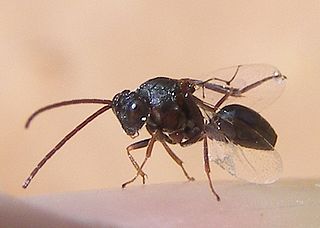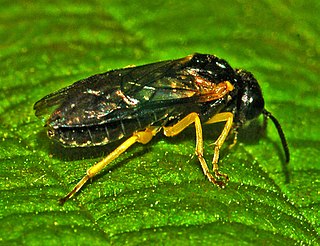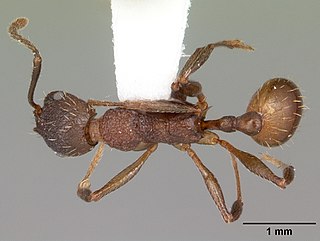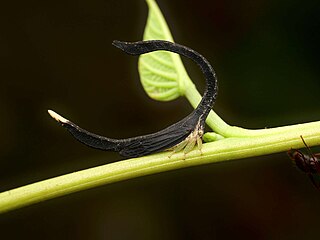
Figitidae is a family of parasitoid wasps. The full diversity of this wasp family is not yet known, but about 1400 species have been described to over 130 genera. For example, the largest subfamily, Eucoilinae, has over 1000 described species so far, but this is probably just a fraction of the total diversity. Figitid species occur throughout most of the world.
Euleia fratria is a species of tephritid or fruit flies in the genus Euleia of the family Tephritidae. The species was first classified in 1862, and is native to North America. Adults have been reared from Angelica atropurpurea, Angelica hendersonii, Cicuta douglasii, and numerous other Apiaceae plants. Larvae are leaf miners, and may pupate within their host plant or in soil.

Neodiprion is a genus of sawflies in the family Diprionidae.

Trissolcus japonicus, the samurai wasp, is a parasitoid wasp species in the family Scelionidae, native to east Asia but now found in Europe, North America, and Chile. It is chiefly known for parasitizing Halyomorpha halys. It deposits eggs into the eggs of the stink bug, and as the wasp larvae develop, they kill the stink bug eggs. A single adult wasp emerges from each stink bug egg.
Theocolax elegans is a parasitic wasp species in the genus Theocolax. It is a parasite of immature stages of stored grain pest insects such as Sitophilus granarius or Rhyzopertha dominica

The genus Caliroa is a group of sawflies in the family Tenthredinidae. The larvae are slimy in appearance, and are sometimes referred to as "slugs" although they are insects rather than gastropods.

Cleonymus is a genus of wasps in the family Cleonymidae. There are more than 40 described species in the genus, which has been recorded on every continent except Antarctica.
Ormocerus dirigoius is a species of stingless wasp. It is native to Maine, United States. It is likely a parasitoid of an oak gall wasp in the family Cynipidae. This species was found in bi-catch of samples collected for another research project.

Aneugmenus is a genus of sawfly.
Cerataphis is a genus of witch hazel and palm aphids in the family Aphididae. There are about 10 described species in Cerataphis.

Aphaenogaster mariae is a species of ant in the family Formicidae. It nests in dead branches or beneath live bark of oak trees. Male specimens of this species were only discovered in 2021. The species is found in the eastern United States.
Caliroa dionae is a sawfly whose larvae eat the leaves of the blueberry plant. It was first discovered near Trois-Rivieres, Quebec.

Acordulecera is a genus of sawflies in the family Pergidae. There are more than 20 described species in Acordulecera.

Strongylogaster is a genus of insects belonging to the family Tenthredinidae.
Pseudodineura is a genus of sawflies belonging to the family Tenthredinidae.
Chlorocytus is a genus of wasps belonging to the family Pteromalidae.

Disholcaspis quercusmamma, the oak rough bulletgall wasp, is a species of gall wasp in the family Cynipidae. The quercus in its name is the genus name for oak, while "mamma" is Latin for "breast", presumably a reference to the "nipple" on the gall.
Raymond J. Gagné is an American entomologist whose work focuses on gall midges.

Cladonota is a genus of neotropical treehoppers widespread from Mexico to South America. They are known for their elaborate pronotum shapes, hypothesized to play a role in camouflage or mate recognition, although their function is not yet known with certainty. Previously described as a subgenus of Sphongophorus, it was recognized as a genus of its own right in 1997 after the latter was synonymized with Hypsauchenia.











